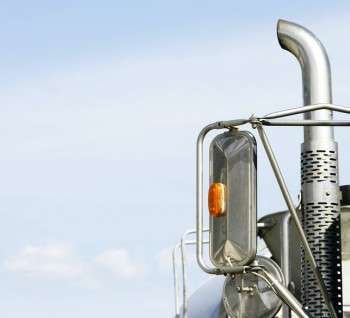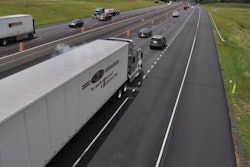
The U.S. Environmental Protection Agency (EPA) and the U.S. Department of Transportation’s National Highway Traffic Safety Administration (NHTSA) Tuesday finalized new emissions and fuel economy standards for medium- and heavy-duty vehicles.
The final Phase 2 standards follow immediately Phase 1 greenhouse gas and fuel efficiency (GHG/FE) standards that won’t be fully implemented until next year.
The EPA says in the 1,690 page document published Aug. 16 that it expects final standards to lower CO2 emissions by approximately 1.1 billion metric tons and save vehicle owners about $170 billion in fuel costs, while reducing oil consumption by up to 2 billion barrels over the lifetime of the vehicles sold under the program.
However, to hit those marks, the agencies are asking for better performance from North American truck and engine makers and testing the imaginations of their engineers.
“As the primary manufacturers of medium and heavy-duty engines and vehicles in the United States, EMA members are in the process of implementing the Phase 1 GHG/FE standards,” says Jed Mandel, president of the Truck and Engine Manufacturers Association (EMA). “The success of the Phase 1 implementation is directly tied to the fact that the 2011 standards were well matched with EMA member efforts to meet customer demand for more fuel efficient vehicles. We are in the process of reviewing today’s highly complex rule to determine if it aligns with manufacturers’ efforts and customer needs. If not, the Phase 2 program would impose enormous costs on our customers, constrain customer choice, and, as a result, impose significant challenges to its successful implementation.”
By model year (MY) 2027 – when the Phase 2 standards are fully phased in – tractors in a tractor-trailer combination must achieve up to 25 percent lower CO2 emissions and fuel consumption than an equivalent tractor in 2018.
Allen Schaeffer, executive director of the non-profit Diesel Technology Forum, says tightening regulations must strike a delicate balance between what is possible and what is practical. In addition to compliance with these new fuel economy and greenhouse gas emissions requirements on a wide variety of customizable products, heavy-duty engine and truck manufacturers must also ensure near zero emissions performance for at least 435,000 miles.
“In addition to meeting all the latest federal safety requirements and having the highest uptime and reliability, the largest trucks must be able to move 80,000 pounds up mountains at 60 miles per hour, run 100,000 to 120,000 miles a year, in every corner of the United States,” he says, “while doing it all at the lowest possible cost.
For diesel tractor engines, the agencies are adopting standards for MY 2027 that are more stringent than the preferred alternative from the original proposal, and will require reductions in CO2 emissions and fuel consumption that are 5.1 percent better than the 2017 baseline for tractor engine. The agencies are also adopting standards for MY 2021 and MY 2024, requiring reductions in CO2 emissions and fuel consumption of 1.8 to 4.2 percent better than the 2017 baseline tractor engines.
For vocational diesel engines, the new standards will require reductions of 2.3, 3.6, and 4.2 percent in MYs 2021, 2024, and 2027, respectively. These levels are more stringent than the proposed standards for these same MYs, and approximately as stringent in MY 2021 and MY 2024 as the Alternative 4 standards discussed during proposal.
“Efficiency is by no means a new concept to diesel engine and truck manufacturers,” Schaeffer adds. “This new rule raises the bar, demanding even further innovation while recognizing the unique considerations of the trucking industry and many differing commercial heavy-duty applications.”
Phase 2’s vehicle and engine performance standards cover MY 2021-2027, and apply to semi-trucks, large pickup trucks and vans, and all types and sizes of buses and work trucks. These standards will result in significant GHG emissions reductions and fuel efficiency improvements across all of these vehicle types, the agencies claim and project that these reductions will be “maximum feasible and reasonable amounts for diesel engines based on technological changes that will improve combustion and reduce energy losses.”
For most of these improvements, the EPA and NHTSA project that manufacturers will begin applying improvements to about 45 percent of their heavy-duty engines by 2021, and ultimately apply them to about 95 percent of their heavy-duty engines by 2024.
“However, for some of these improvements we project more limited application rates,” the final ruling reads. “In particular, we project a more limited use of waste exhaust heat recovery systems in 2027, projecting that about 10 percent of tractor engines will have turbo-compounding systems, and an additional 25 percent of tractor engines will employ Rankine-cycle waste heat recovery.”
EPA also proposed a number of changes and clarifications for rules respecting glider kits and glider vehicles. The final rule contains emission standards for glider vehicles, but does not contain separate standards for glider kits. Under the final rule, gliders will largely be considered new trucks, meaning the engines installed in them must be emissions complaint with the model year in which the truck is assembled.
To reflect these considerations, the EPA is adopting provisions stating that a glider kit becomes a vehicle when “it includes a passenger compartment attached to a frame with one or more axles.”
“The EPA sees nothing in the Act that compels the result that adding a used component to an otherwise new motor vehicle necessarily vitiates classification of the motor vehicle as ‘new,'” the agency wrote. “The fact that this approach is reasonable, if not mandated, is confirmed by the language of the Act’s definition of ‘new motor vehicle engine,’ which includes any ‘engine in a new motor vehicle’ without regard to whether or not the engine was previously used.”

The agencies are also finalizing fuel efficiency and GHG standards for trailers for the first time. The EPA trailer standards will take effect in MY 2018 for certain trailers, while NHTSA’s standards will take effect as of 2021. Credits will be available for voluntary participation before then.











